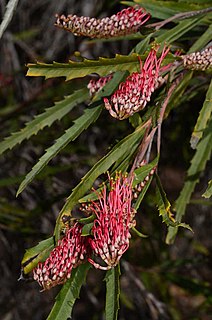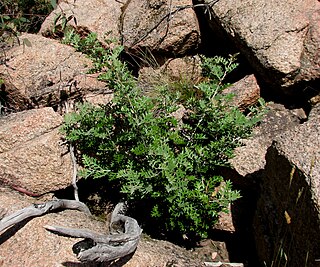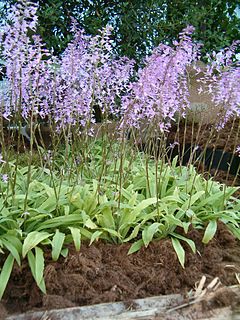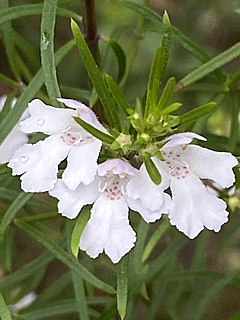
Morinoideae is a subfamily of plants in the family Caprifoliaceae, order Dipsacales. It was at one time recognized as the separate family Morinaceae. The genus Morina has also been included in a separate family Dipsacaceae, currently included in Caprifoliaceae. Three genera have been included in this subfamily:

Valley of Flowers National Park is an Indian national park which was established in 1982. It is located in Chamoli in the state of Uttarakhand and is known for its meadows of endemic alpine flowers and the variety of flora. This richly diverse area is also home to rare and endangered animals, including the Asiatic black bear, snow leopard, musk deer, brown bear, red fox and blue sheep. Birds found in the park include Himalayan monal pheasant and other high altitude birds.

Grevillea longifolia, commonly known as fern-leaf spider flower, is a species of flowering plant in the family Proteaceae and is endemic to the Sydney Basin in New South Wales. It is an erect to spreading shrub with narrowly egg-shaped to almost linear leaves, and toothbrush-like groups of pinkish-fawn flowers with a pink to red style. It is fairly readily grown in gardens.

Cephalanthera longifolia, the narrow-leaved helleborine, sword-leaved helleborine or long-leaved helleborine, is a rhizomatous herbaceous perennial plant in the family Orchidaceae. It is native to light woodland, and widespread across Europe, Asia and North Africa from Ireland and Morocco to China. This includes the United Kingdom, Iran, Russia, Kazakhstan, Turkey, Algeria, India, Pakistan, Germany, Italy, France, Spain, Portugal and many other countries.

Eremophila longifolia, known by a range of common names including berrigan, is a flowering plant in the figwort family, Scrophulariaceae and is endemic to Australia. It is a shrub or small tree with weeping branches, long, narrow leaves and brick-red or pink flowers and is found in all Australian mainland states and the Northern Territory.

Lomandra longifolia, commonly known as spiny-head mat-rush, spiky-headed mat-rush or basket grass, is a perennial, rhizomatous herb found throughout eastern Australia. The leaves are 40 cm to 80 cm long, and generally have a leaf of about 8 mm to 12 mm wide. It grows in a variety of soil types and is frost, heat and drought tolerant. Labillardiere described Lomandra longifolia from a specimen collected in Tasmania.

Notelaea longifolia is a very common shrub or small tree in eastern Australia. Occurring in or adjacent to rainforest from Mimosa Rocks National Park to Bamaga in far north Queensland. Common names include large mock-olive or long-leaved-olive. An attractive ornamental plant.

Grevillea willisii is a shrub species which is endemic to the eastern highlands of Victoria, in Australia. Common names include Omeo grevillea and rock grevillea.

Grevillea brevifolia, commonly known as Cobberas grevillea, is a species of flowering plant in the family Proteaceae and is endemic to south-eastern continental Australia. It is a spreading shrub with hairy branchlets, elliptic leaves and clusters of hairy red flowers.

Magnolia × alba, also known as the white champaca, white sandalwood, or white jade orchid tree, is a flowering plant of hybrid origin that is commonly cultivated in Southeast Asia and tropical regions of East Asia. Although the exact origin is uncertain, it is considered to be a hybrid of Magnolia champaca and Magnolia montana.

Petrophile longifolia, commonly known as the long-leaved cone bush is a shrub which is native to the south west of Western Australia, growing between the city of Albany and the Stirling Range.

Cassinia longifolia, commonly known as shiny cassinia, is a species of flowering plant in the family Asteraceae and is endemic to eastern Australia. It is an erect, aromatic shrub with sticky, hairy foliage, linear or oblong to narrow lance-shaped leaves, and heads of creamy-white flowers arranged in a dense corymb.

Hovea longifolia commonly known as rusty pods, is a flowering plant in the family Fabaceae, endemic to eastern Australia. It has purple pea flowers, linear leaves with rusty felt like hairs on the lower surface.

Dianella longifolia, commonly known as blueberry lily, pale flax lily or smooth flax lily, or blue flax-lily, is a species of flowering plant in the family Asphodelaceae and is endemic to non-arid areas of Australia. It is a tufted, rhizomatous, perennial herb with grass-like leaves, pale blue, white or greenish flowers that have pale yellow anthers, and shiny, pale blue berries.

Phlomis longifolia, the long-leaved Jerusalem sage, is a species of flowering plant in the mint and sage family Lamiaceae, native to the hills of Cyprus, Turkey and Lebanon.

Stenoglottis longifolia, called the long-leaved stenoglottis, is a species of orchid in the genus Stenoglottis, native to Mozambique, Eswatini, and KwaZulu-Natal in South Africa. It has gained the Royal Horticultural Society's Award of Garden Merit.

Sorbaria tomentosa, the Himalayan sorbaria or Kashmir false spirea, is a species of flowering plant in the family Rosaceae. A shrub with white flowers that can grow up to 6 metres in height. It is native to Afghanistan, Central Asia and the Himalayas, and has been introduced to the South Island of New Zealand. It has gone extinct in Tajikistan. Its putative variety Sorbaria tomentosa var. angustifolia, the narrow-leaved Himalayan sorbaria, has gained the Royal Horticultural Society's Award of Garden Merit.

Westringia longifolia, commonly known as long-leaved westringia, is a flowering plant in the family Lamiaceae and is endemic to southeastern Australia. It is a small shrub, with linear leaves and mostly white flowers.

Viburnum grandiflorum, variously called the cranberry bush, flowering viburnum, grand viburnum, and Himalayan viburnum, is a species of flowering plant in the family Viburnaceae, native to the Himalayan region. A sparse shrub or gnarled tree reaching 2–3 m (7–10 ft), it has showy pink flowers, larger than the typical viburnum, and red to black fruit, which are edible. It is hardy to USDA zone 6a. It grows in open forests. The unimproved species is available from commercial suppliers, and there is a putative form, Viburnum grandiflorum f. foetens, the stinking Himalayan viburnum, and a number of cultivars, including 'De Oirsprong', 'Desmond Clarke', and 'Snow White'.

Mirbelia longifolia is a species of flowering plant in the family Fabaceae and is endemic to the south-west of Western Australia. It is an erect shrub that typically grows to a height of 0.6–2.4 m and has yellow or orange and purple flowers from September to October. It was first formally described in 1942 by Charles Gardner in the Journal of the Royal Society of Western Australia. The specific epithet (longifolia) means "long-leaved". This mirbelia grows on stony soil in the Avon Wheatbelt, Geraldton Sandplains and Yalgoo bioregions of south-western Western Australia, and is listed as "not threatened" by the Government of Western Australia Department of Biodiversity, Conservation and Attractions.





















